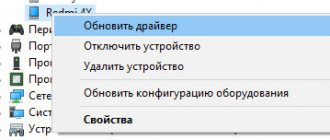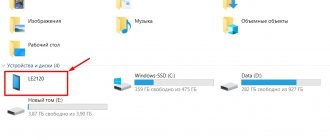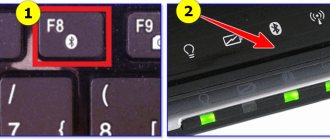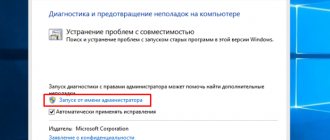Published: 08/31/2019 Category: Troubleshooting Author: Alexander Roshchin
While using the video card, we suddenly discover that the computer has stopped recognizing it, although it was working stably even before the system was rebooted. You can find out that the PC does not see it in the Task Manager, where the standard video adapter is displayed instead of the model name, or when applications that depend on this graphics processor cannot be launched.
You can encounter this problem even after replacing it with a new or known working device. For example, after a purchase, when we thoroughly studied its characteristics and compared it with other models that are fully compatible with the PC configuration in use, we notice that the computer categorically refuses to recognize the new video card.
A detection problem may occur due to faulty drivers, incorrect BIOS settings, hardware problems, a broken video card, or caused by power outages. In general, there are many reasons why the computer does not see a discrete video card, and they depend on whether you are using a new device or the system suddenly stopped detecting it.
- 1 Check the video card socket and contacts
- 2 Reinstalling the driver
- 3 Setting the default video card
- 4 Insufficient power supply
- 5 Changing BIOS settings
- 6 Uninstall Windows updates
- 7 Reset BIOS settings
Check the video card socket and contacts
The problem may arise due to the state of the video card mounting location. The socket may be damaged, for example, when cleaning the system unit, or may not work correctly due to a layer of dust.
Note: If the video card worked normally, first of all you need to clean the connectors from dust, remove the video adapter, carefully wipe the contacts with an eraser, put it back and secure it tightly.
Open the cover of the system unit, turn on the computer and see if the fan on the GPU is spinning. If not, the connector is faulty or the video card is not securely secured in the socket. If everything is in order with the contact, install it in the second slot (if available) or check on another computer.
Lost contact
Even though the video card is secured to the motherboard, it may lose contact due to vibration or strong shocks. This problem is resolved by disassembling the case. You need to remove the card, inspect the condition of the connector, degrease the board contacts and clean them with a rubber band.
This work should be entrusted to specialists. The laptop is taken to a service or qualified workshop. However, if you have some skills in working with a screwdriver and are careful, you can do everything yourself.
Advice! Before starting the operation, it is recommended to look on the Internet how to disassemble a particular laptop model.
Reinstalling the driver
Check in Device Manager if the system sees the video card. If the device displays correctly, try reinstalling the drivers. First you need to completely delete the current and associated files. Download and install the DDU utility from the official website.
Then start your computer in Safe Mode. Open the Start menu, click the "Power" button and, while holding Shift, click on "Restart".
When the recovery environment window appears, go to: Troubleshooting – Advanced options – Boot options. When the startup options are displayed, press F4 to enter Safe Mode.
Run the DDU utility, specify the GPU model on the first screen and follow the first step (uninstall and restart).
Then download the latest software from the NVIDIA or AMD website.
Run the installation file and follow the on-screen instructions until the driver installation is complete.
About the problem itself and accompanying symptoms
The absence of a video card in the list of devices may be accompanied by a sharp drop in performance in games and graphics applications. This can be caused by a simple power outage and a sudden shutdown of the PC. Then, when loading, many errors often occur. Incorrect shutdown of Windows can also damage system files that are required for the correct operation and display of devices.
The first thing you can do if the video adapter is not in the device manager list is to scan the system files. If necessary, broken files must be replaced with working ones. To carry out diagnostics, do the following:
- Launch the Run service using the Win+R key combination.
- Enter the scf / scannow command and wait until the system completes the scan.
Run a system file scan
- Next you will need to restart your PC.
If no system errors are detected, but we still don’t see the card in the device manager, we move on to other solutions.
In the case of two video cards, when checking the “Video Adapters” category (Device Manager), only the built-in adapter may be displayed. In other cases, the user may observe an unknown device detected on the system in the Other devices category. Finally, the user may accidentally remove the video adapter from the list.
Checking the status of the graphics adapter in Device Manager
Setting the default video card
Sometimes the problem can be resolved by setting the default video card for a specific application. This binding can be configured in the NVIDIA Control Panel or using the Catalyst Control Center for AMD utility.
Here are instructions on how to do this for NVIDIA video cards. Open Control Panel by right-clicking on the desktop.
Go to the "Manage 3D Settings" section and open the "Program Settings" tab. Now select the program you want to assign your video card to run. In the drop-down window for selecting your preferred GPU, select the high-performance NVIDIA processor.
Save the settings and exit Control Panel. Try running the program that has been assigned the default NVIDIA video card. If it starts successfully, repeat the steps for other main applications.
Debugging the PCI bus driver
If the problem persists, the next step in resolving the problem is to create a new system configuration in which the primary Microsoft graphics card must be removed. The operation is performed according to the following instructions:
- Click on the “Run with RMB” icon.
- Launch Command Prompt with administrator rights.
- Create a backup of your current settings by typing “bcdedit /export D:\bcd_backup.bcd”, where instead of “D” you specify the name of the drive where you want to save the backup.
- Press the Enter key.
Insufficient power supply
If you installed a new video card, but the computer does not see it, then the reason is related to the power supply. If the old discrete card works flawlessly, but the system refuses to recognize the new one, most likely the power supply is not powerful enough for it.
Check the power rating of the power supply and how much power the new video card requires. Even if the power supply meets the minimum requirements, it must be replaced. Therefore, check that the power supply has more power than required for the discrete card.
Keep in mind that for an approximate calculation you need to sum up the power of all devices installed in the system unit.
Also, check that all power cables are connected. Just because you see the fans spinning does not mean the cables are connected correctly. Sometimes, due to poor contact in the additional power connector, for example, broken after cleaning the computer, we suddenly discover that the system does not see the graphics card.
When choosing, give preference to power supplies from well-known manufacturers. They are more expensive, but you will be sure that they provide the declared power. Well-known brands include EVGA, Corsair, Cooler Master and SeaSonic.
The computer does not see the discrete video card
This problem is often encountered by those who reinstalled operating systems when an error occurred during installation. The solution is possible if you reboot the OS, or boot from Livecd.
Another solution is possible when deleting all drivers that mention Nvidia, disable the folder called Nvidia. Clean the registry. Disconnect the Internet, antivirus, reboot and install the drivers again. BUT if the proposed manipulations do not help, you need to contact the service center. They will solve problems with repairs and adjustments.
Changing BIOS Settings
There are several settings in the BIOS that you need to change if you are having problems detecting your video card. Turn on your computer and when the first logo screen appears, press Esc, Del, F8, F12, or F10. You can find out the exact key to enter the BIOS on this screen or by searching on the Internet for the motherboard model.
In the BIOS settings, find the IGPU or iGPU Multi Monitors options. This option allows you to configure and use multiple monitors. It must be disabled if only one monitor is connected to the computer.
Find settings related to PCI and PCI-E. There should be the following parameters: PCI, Onboard and PCI-e. Try selecting the PCI-e option and check if the problem is resolved.
The computer does not see the video card after loading the OS
This malfunction should be attributed to a malfunction in the operating system. It manifests itself as follows: a game or any application that uses the power of a video card produces errors about the absence of a graphics card on the computer and/or about the lack of video memory to perform a particular task.
To make sure whether your computer sees the NVIDIA video card, you can use the following instructions:
Often the computer does not see the video card, although it is installed and previously worked normally. Most often this happens when reinstalling the operating system or updating hardware. You can determine the reason why the computer does not find the video card and how to fix it yourself. Let's figure it out.
The simplest method of checking system functionality. It is a visual study of a computer and its layout and connections between blocks. All blocks and connecting wires are inspected, their connections are made, whether there are any violations during the connection or not.
If the video card does not work and everything is fine with the connections, plug it into the network and reboot the computer. If the result is negative after rebooting, you should check the BIOS (Basic Input/Output System).
The information that the computer displays on the monitor when it reboots allows you to determine what actions need to be taken to solve the problem with the video card. If there is an inscription on the monitor - Press DEL to enter setup - press, following the rules according to the instructions (on laptops, instead of DEL, you need to press F2 to enter the BIOS). Next, go to the settings menu. In the settings we find the settings for the video card
- Graphic
- V > Video activation. VGA and Primary Display
Uninstalling Windows updates
There are many cases when, after updating Windows, problems arise with drivers, and as a result, the system no longer recognizes the video card. There is an easy way to cancel the update. Windows provides the option to go back to a previous version. Although this option is only available for 30 days, it is worth taking advantage of.
Press the Win + I combination to enter Settings and go to the “Updates and Security” section.
In the left pane, open the Recovery tab and click the Get Started button under the Go back to a previous version of Windows 10 section.
If this section is not available, try uninstalling the latest update. Open the Run window, run the appwiz.cpl command.
On the left side of the screen, click on “Installed updates.”
Find the last update by date, click on the “Uninstall” button and follow the on-screen instructions.
After that, restart your computer and check if the system sees the video card.
OS problems
Older versions of Windows XP do not support switching video adapters. The only thing that is suggested to the user is to change the used video card in the BIOS. This can be done using the Init Display First option. By setting the value to PCI, the discrete card is enabled.
In addition, Windows XP does not work well with nVidia adapters. If the video card has disappeared from the device manager on the laptop, the most reasonable solution would be to rearrange the system. After this, you should download the latest drivers from the manufacturer. They must be installed according to the instructions.
Later versions of operating systems, such as Windows 10, do not have problems with automatic switching between integrated and discrete adapters. However, there are also problems here when the game does not see the video card on the laptop.
Resetting BIOS Settings
The problem can be resolved by resetting the BIOS to default settings. In the BIOS settings, find the option to load default values (Load Setup Defaults). Depending on the motherboard model, the name is slightly different. Click on it and follow the on-screen instructions.
After resetting, check if the problem is resolved. If the computer still does not see the device, try updating the BIOS.
Alexander Roshchin
Software engineer with 20 years of experience.
Equipment check
If your NVIDIA GeForce or AMD Radeon graphics card is still not showing up, you should look for a hardware factor to solve the problem. You need to check the video card components and make sure that the power supply is sufficient for normal operation.
Be sure to check all connecting components. It also cannot be ruled out that it is not the video card that is faulty, but the motherboard. If you have a working graphics card, connect it to your motherboard and make sure it shows up. If the other gadget is also not showing up, you may have to consider replacing the motherboard.
Another way to check is to connect the card to another computer. Of course, not everyone has this opportunity, but if someone can afford a second computer, they should definitely take advantage of it. Nothing changed? Then return the graphics to their original place, restart your computer, try reinstalling the drivers and move on to the next method.
device Manager
The quickest way to resolve the issue when you encounter an NVIDIA display settings error is to use Device Manager to check the adapter's functionality. To do this you need to do the following:
- Open System Search, which is located in the bottom bar of Windows 10. In the search bar, enter “ Device Manager
”. - The search result will appear in the window. Click on the application.
- Expand the section with video adapters.
- If the NVIDIA device is not active and an arrow icon appears next to it, right-click on it and select "Turn on device
». - If the video adapter is already turned on, try rebooting it. To do this, call the context menu and select " Disable device
" A warning window will appear asking you to confirm the action. - Then re-enable your NVIDIA graphics adapter. Check the functionality of the settings window. If this doesn't help, move on to the next step.











